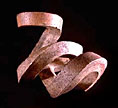(Click on any picture to see an enlargement.)
 |
 |
 |
 |
The didjeridu, also spelled didgeridoo, may be one of the most ancient musical
instruments known to humans. It originated in Australia, and has been used there
by the aboriginal people for thousands of years. Traditional didjeridus are
made of a tree branch that has been hollowed by termites. Beeswax is placed
on the end to make a mouthpiece. Designs with spiritual significance are sometimes
painted on the outside of didjeridus to be used for ceremonial purposes. The
didjeridu is seen as a phallic symbol and male instrument, with women in many
areas traditionally prohibited from playing. Legend has it that if a woman plays
the Didjeridu, she is likely to give birth to twins.
 |
 |
 |
 |
My didjeridus are made from ceramic stoneware, and are quite untraditional in shape and design. The mouthpieces have a smooth glaze finish to make them comfortable to play, although traditional beeswax can be added. They are decorated using clay slips, glazes and/or paints. The clay didjeridus pictured above are from 3 to 5 feet in length. Other instruments I make that are similar to the didjeridu include didjibodhrans and globular horns.
These instruments are created with the utmost respect for the aboriginal people of Australia and their culture and history.
Sound files (available in both au and wav formats):
Watch a video of me playing a clay didjeridu
See how I make clay didjeridus
Return to the Burnt Earth Gallery |